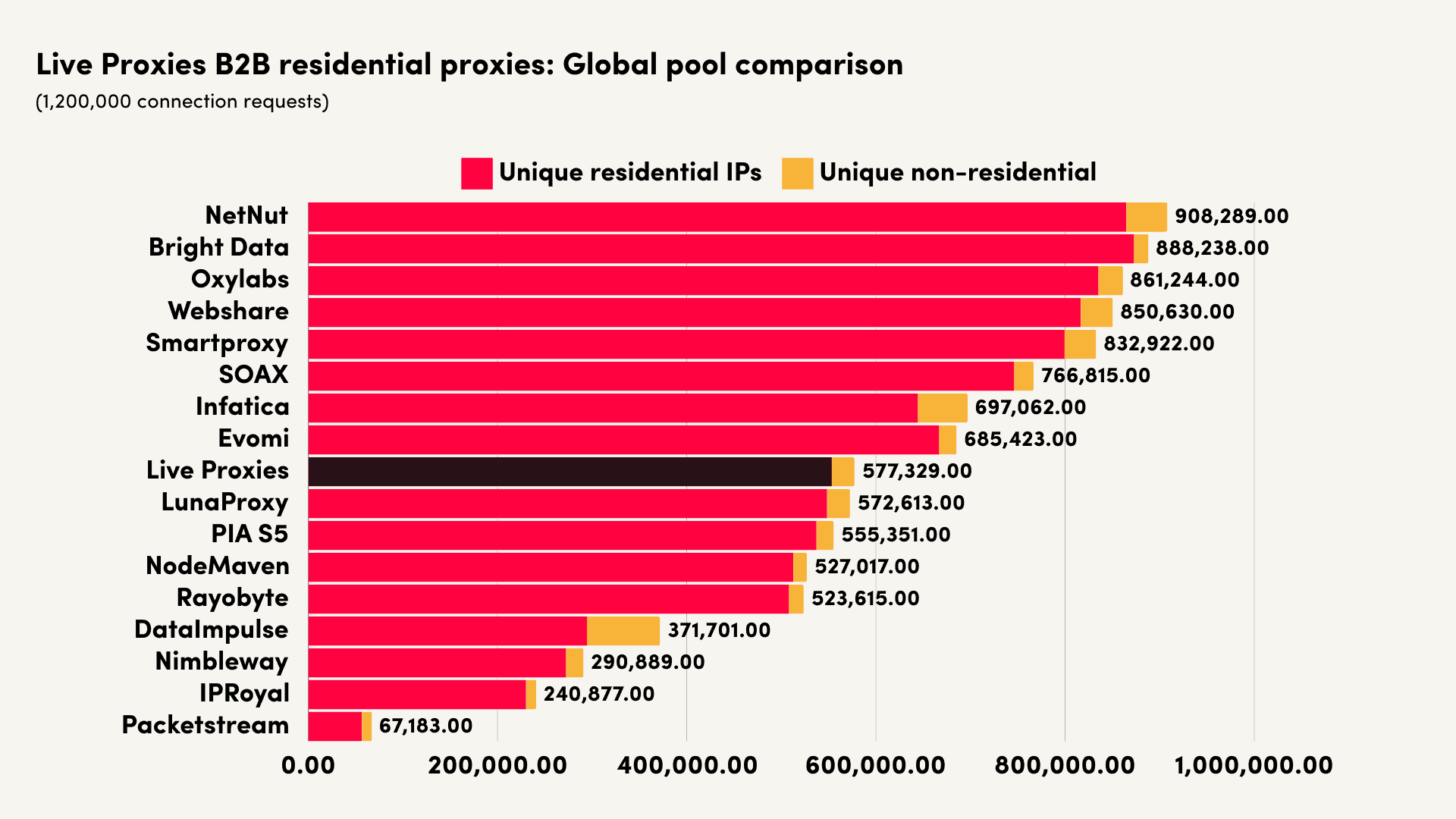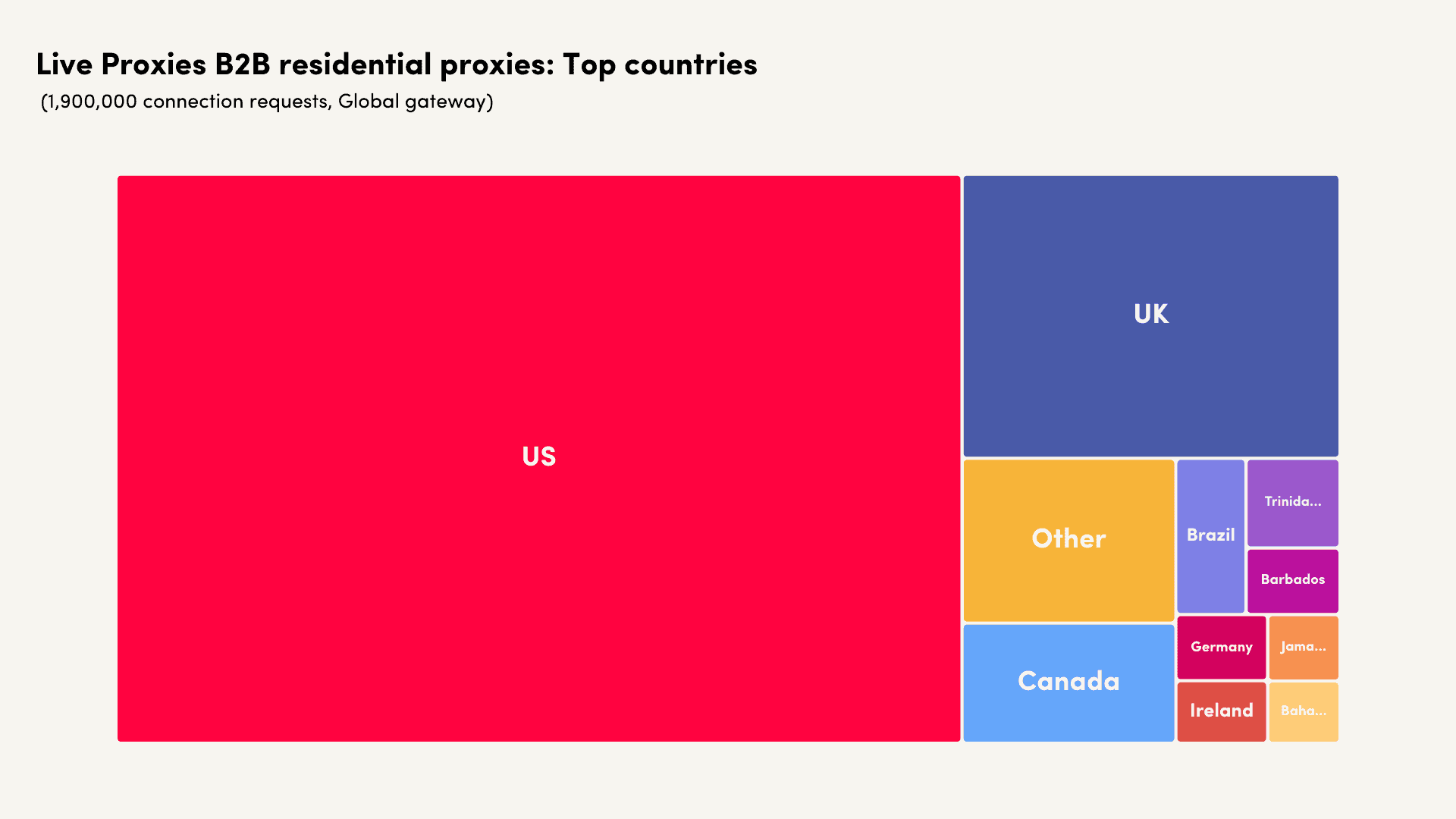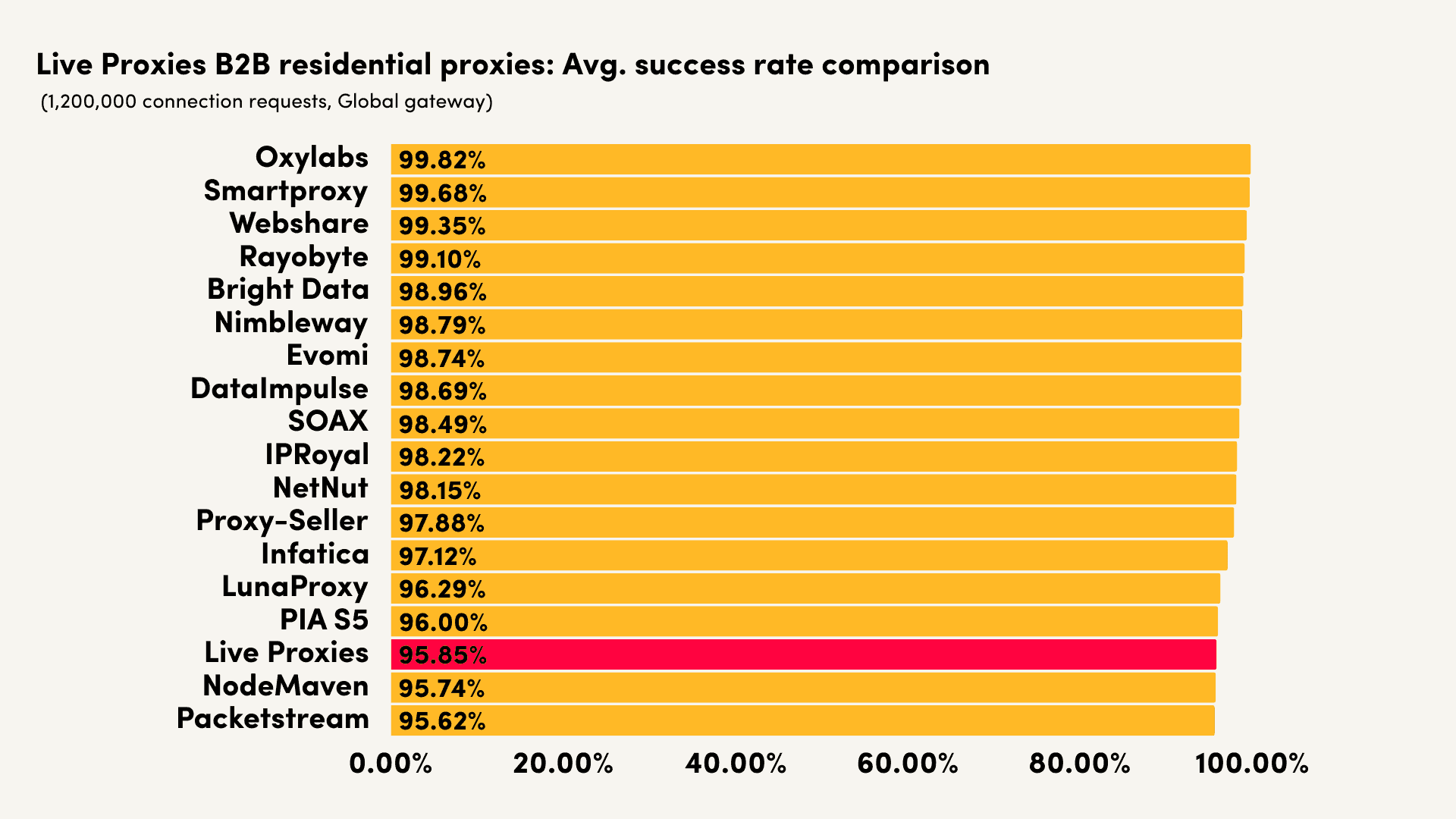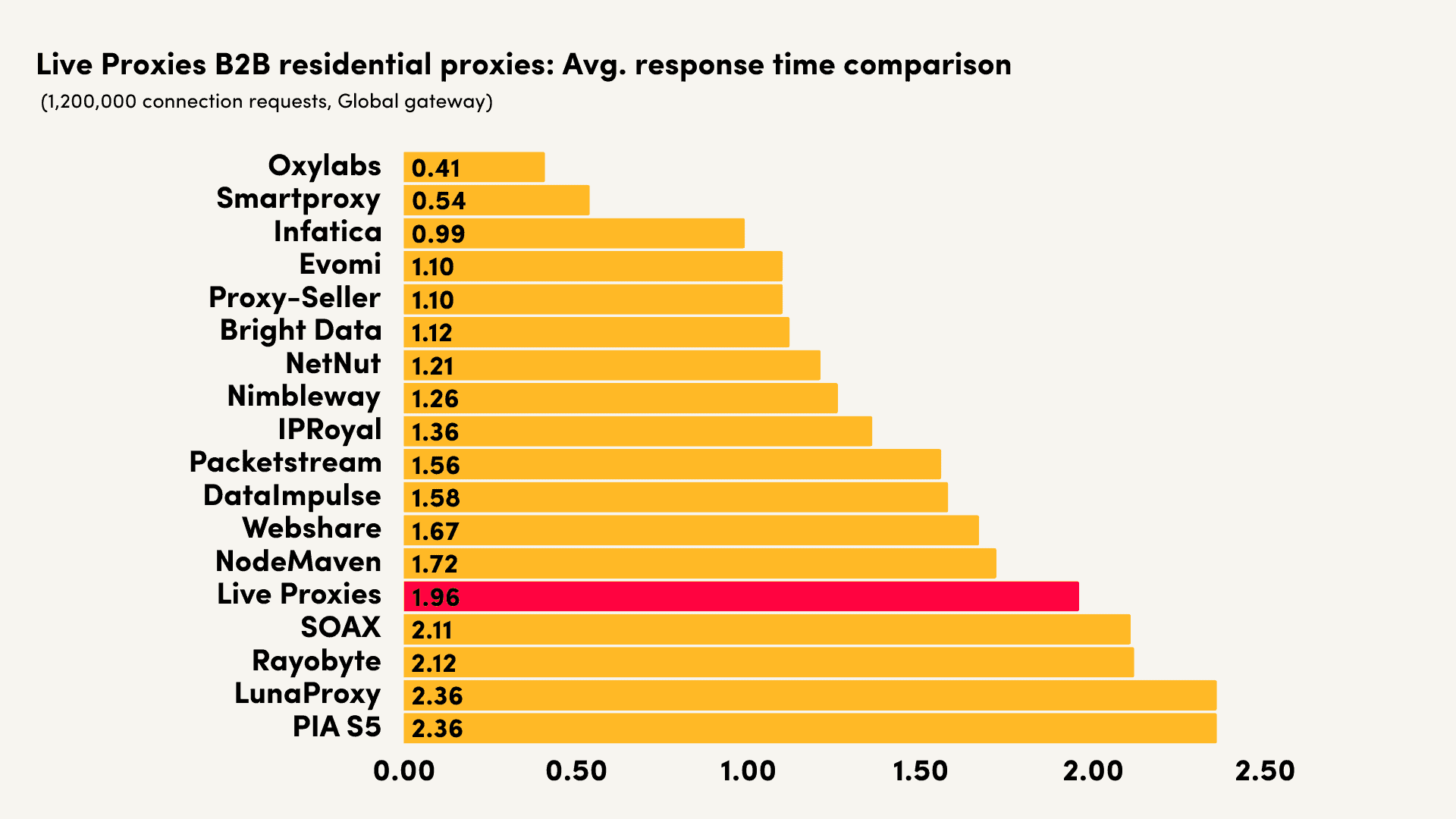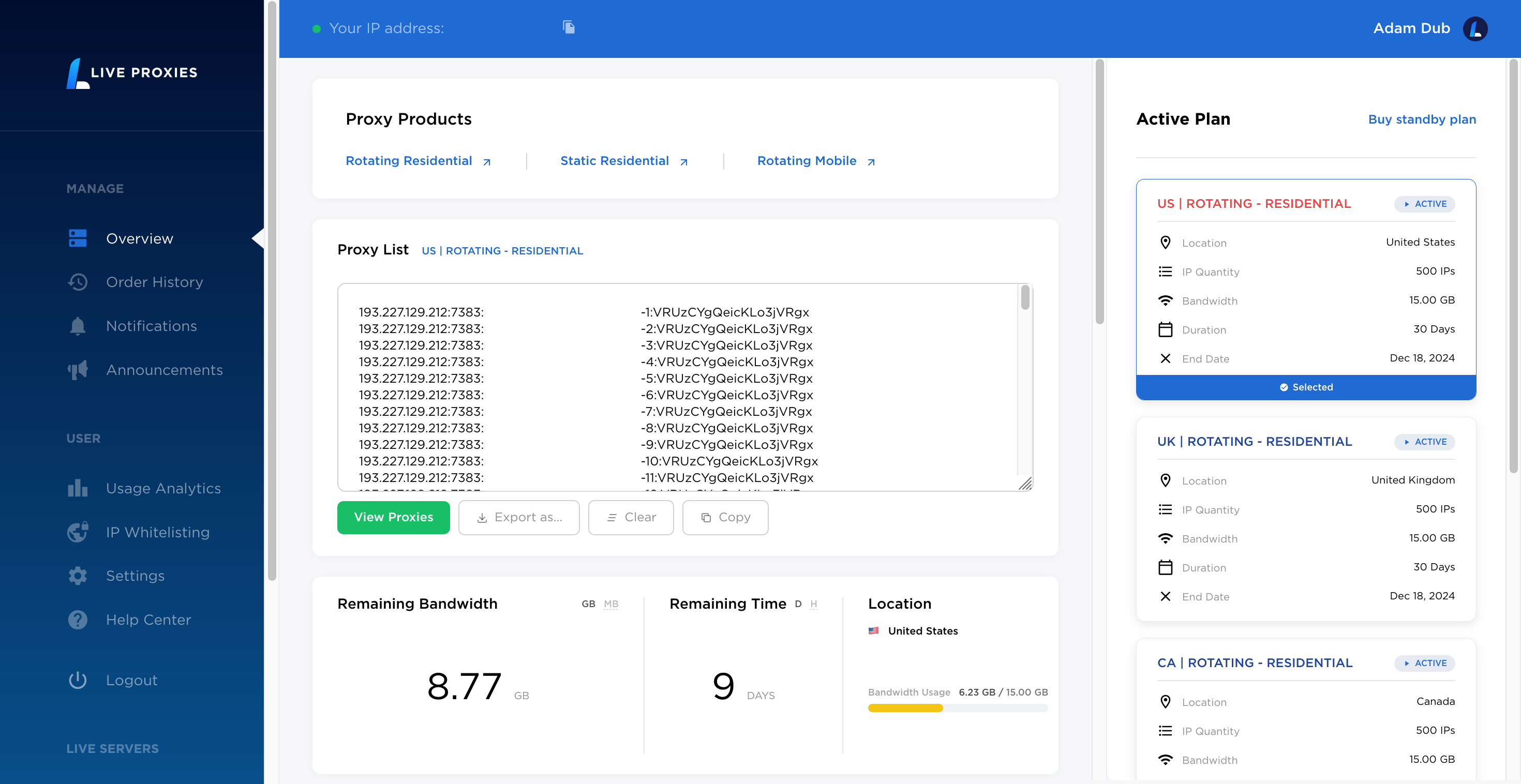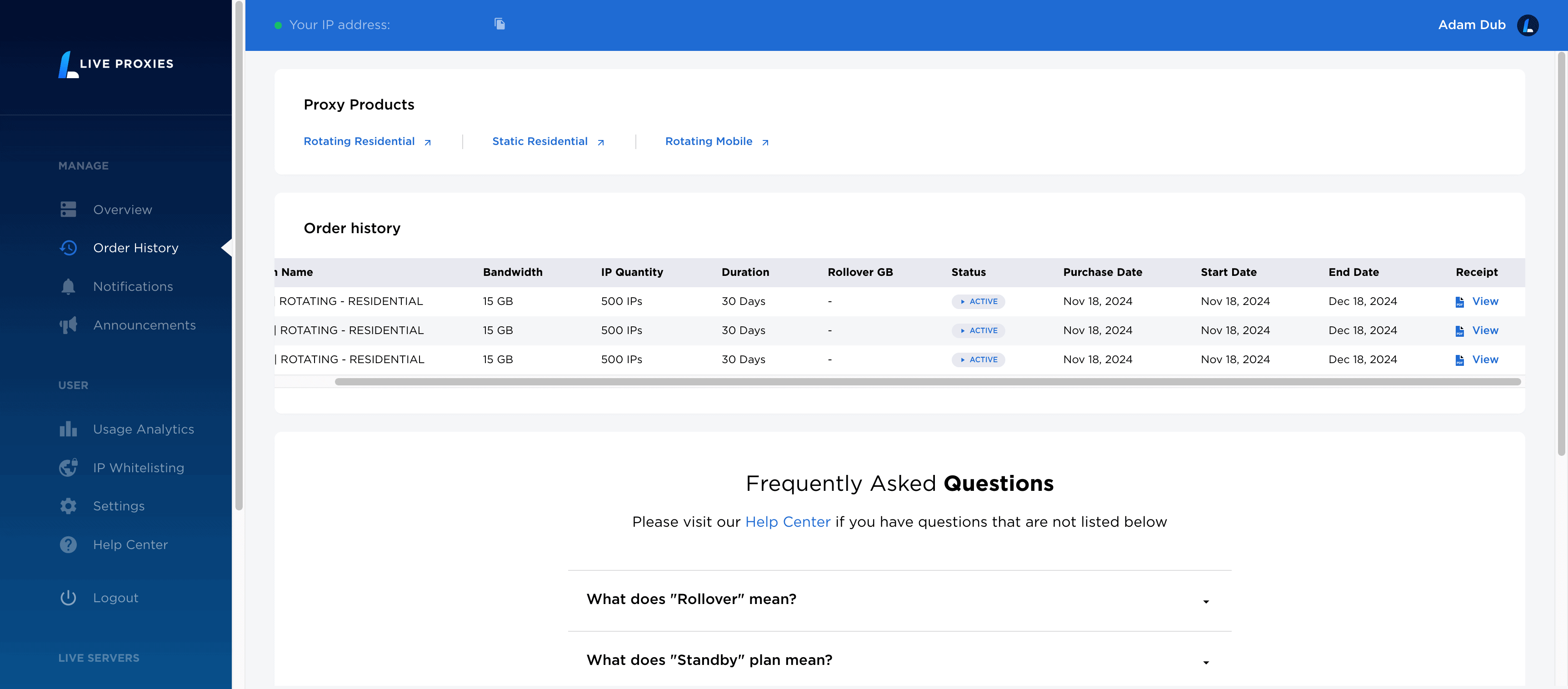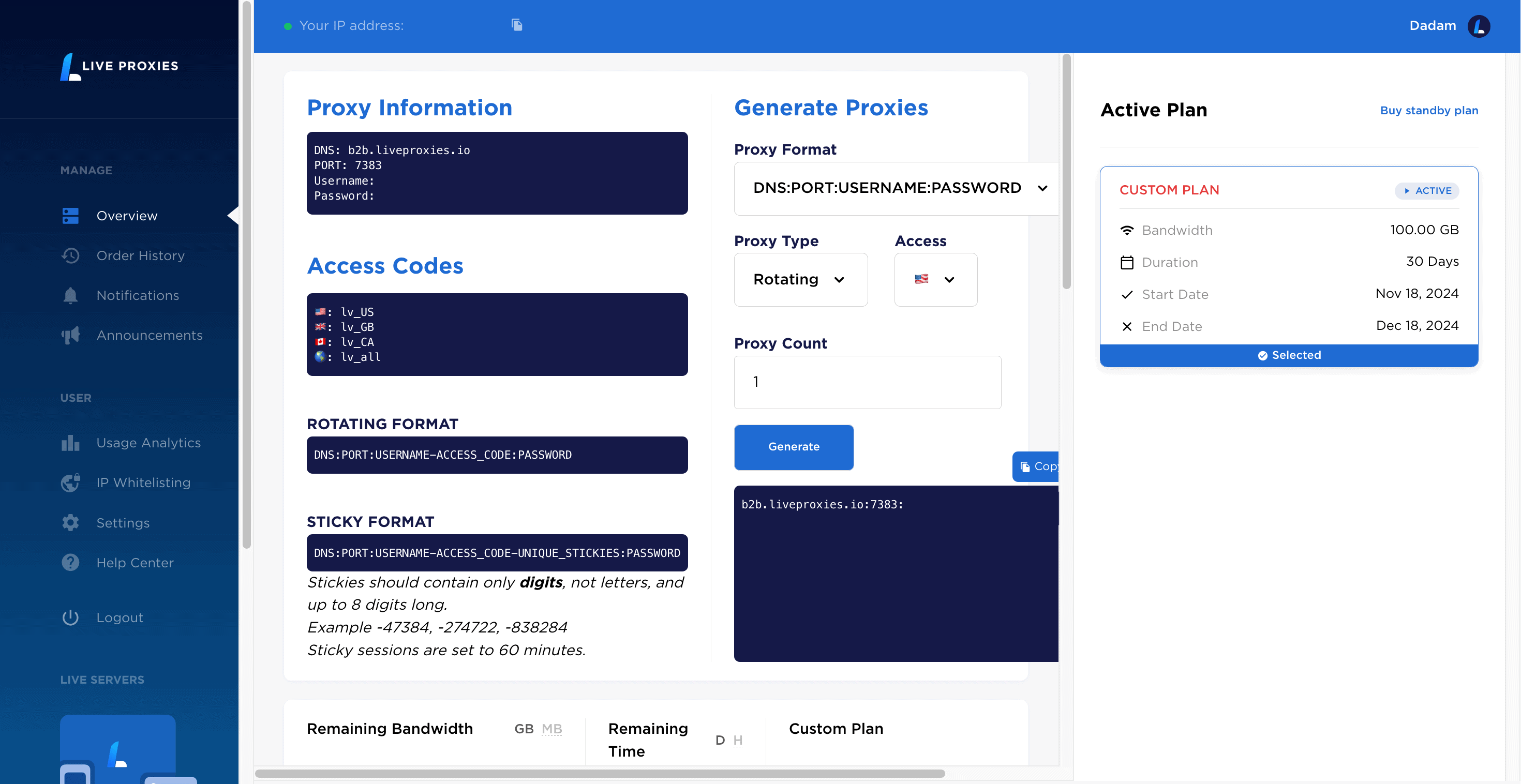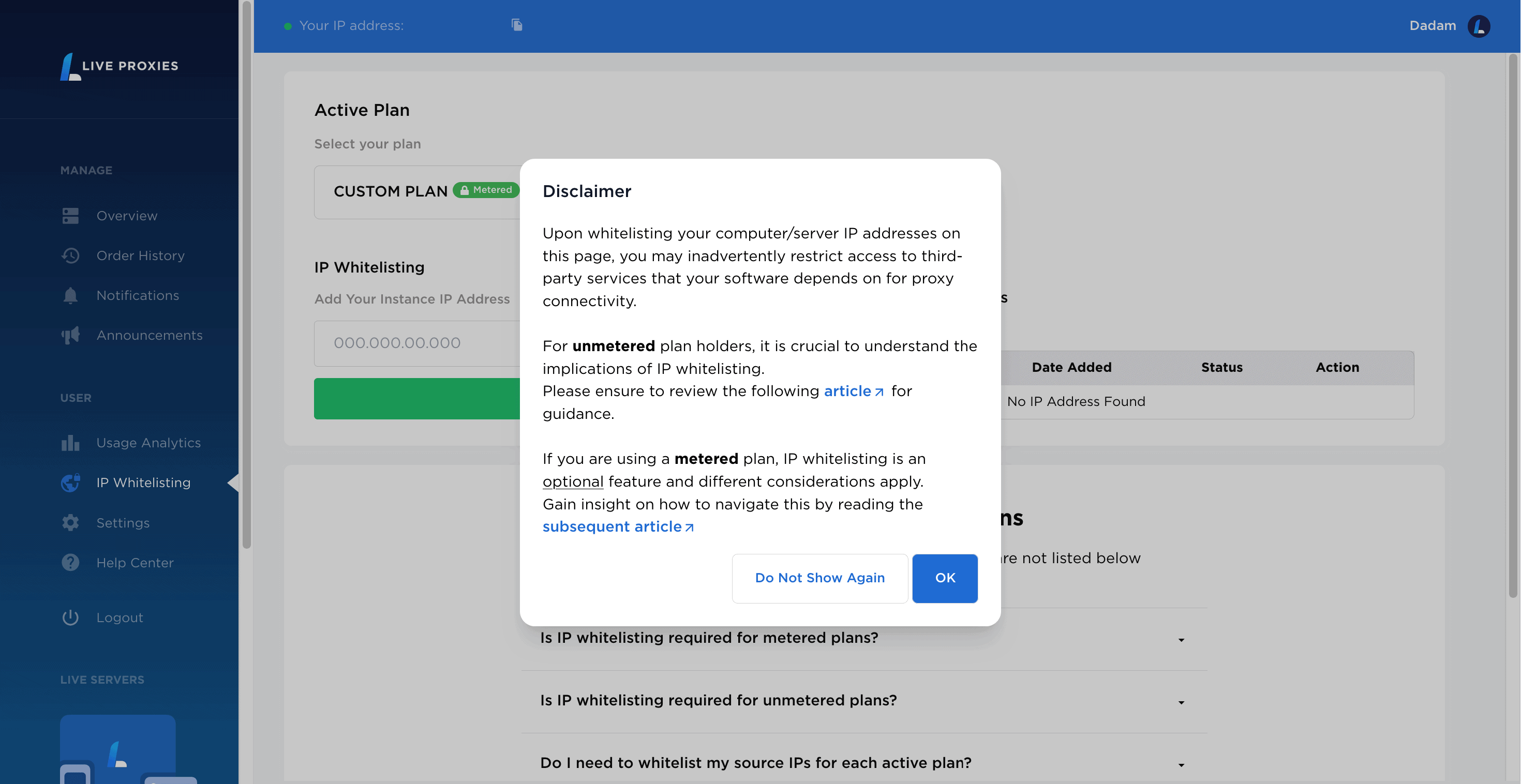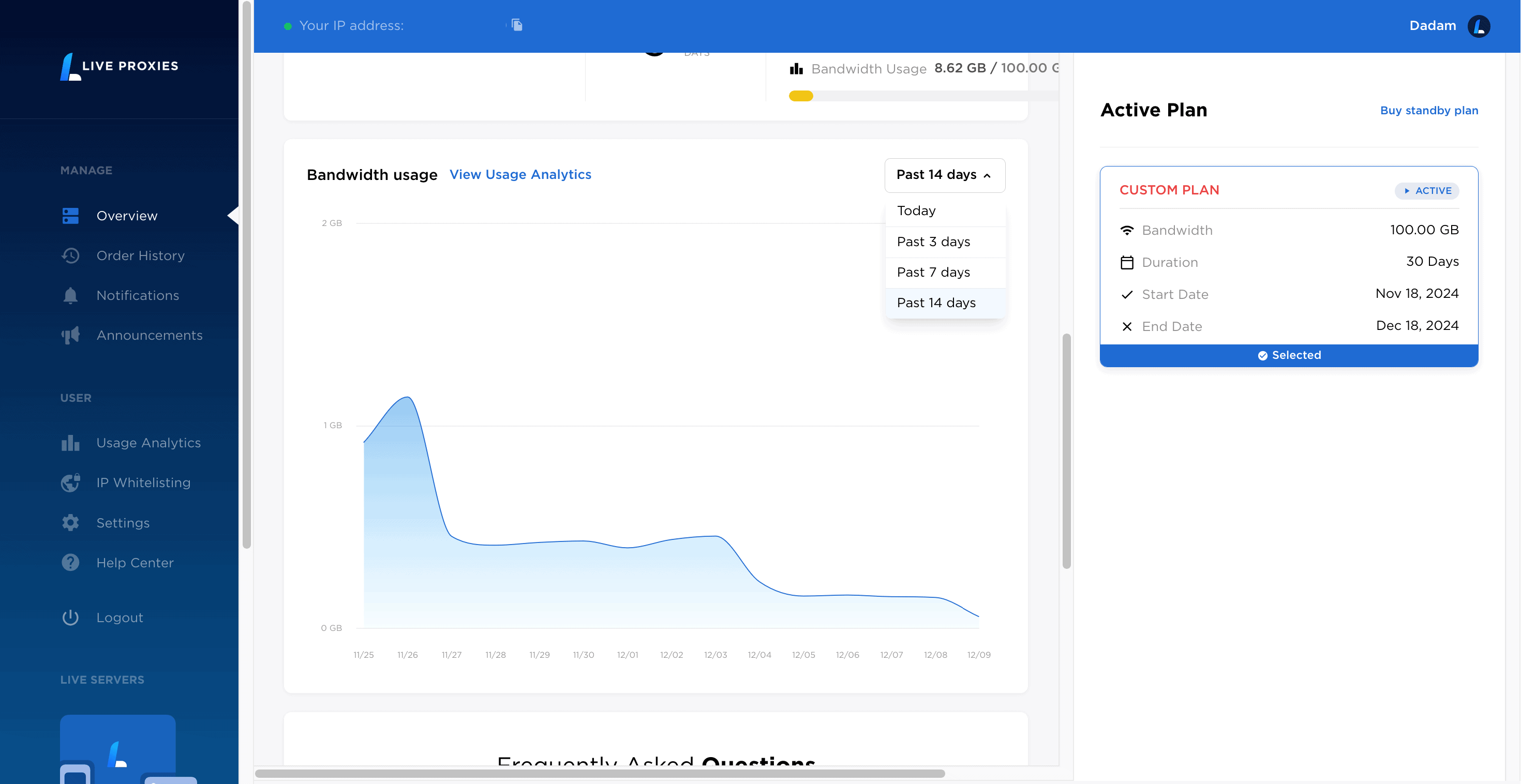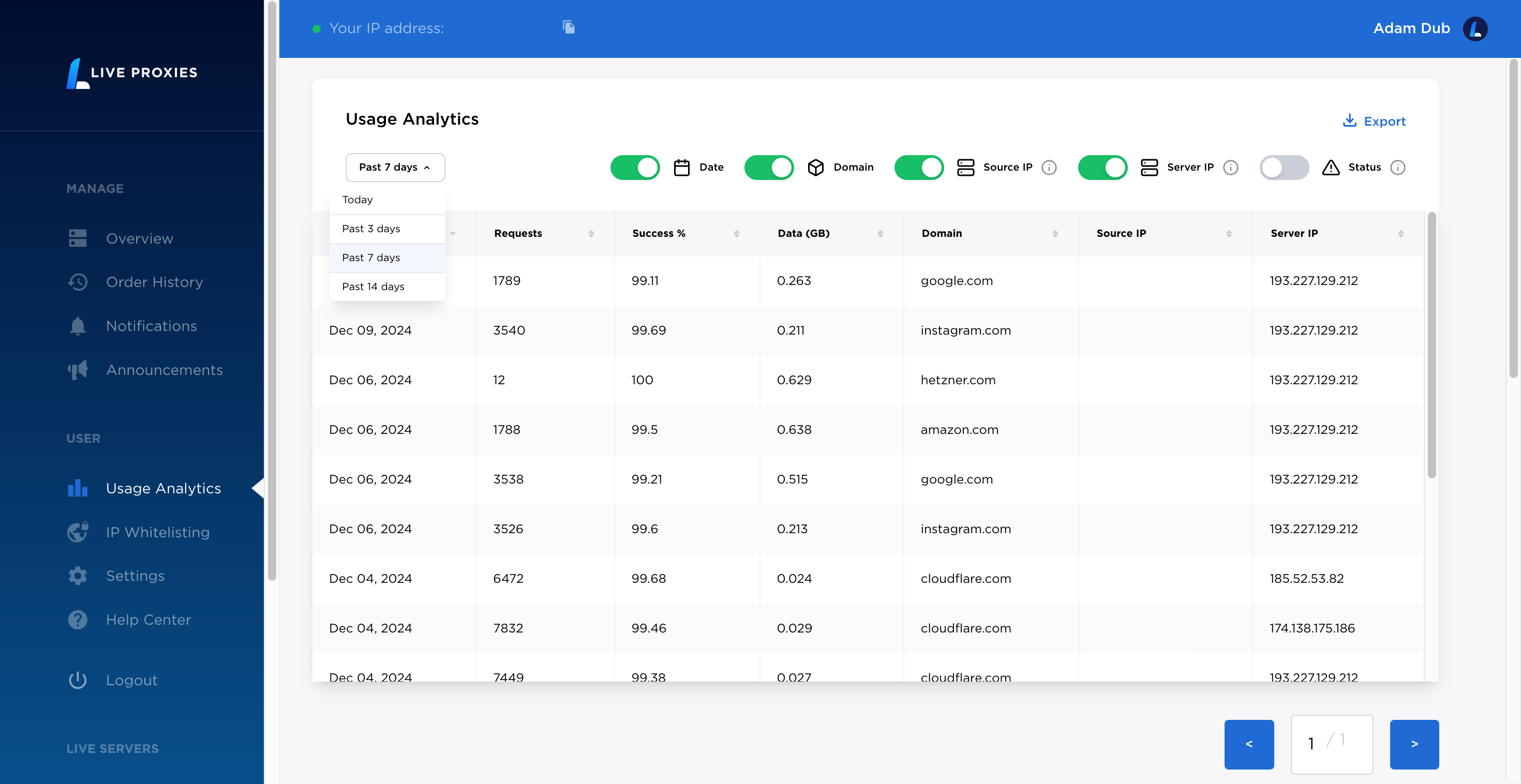
Live Proxies Review
Live Proxies will make you navigate a maze of trade-offs. But in return, you’ll get some quality proxies.
Use the code PROXWAY to get a 20% discount.
Live Proxies makes bold claims: that its proxies are stable, unblocked, and the most reliable. The provider is also one of the few to offer unlimited residential traffic and uptime that’s counted in days rather than minutes.
On the other side of the business, there’s the B2B residential pool that aims to rival the market’s juggernauts like Bright Data and Oxylabs.
The question is: does Live Proxies have enough to woo you away from other premium providers? We tested its B2C and business-oriented residential proxies to find out. Let’s go!
General Information
- Country: US
- Founded: 2020
- Proxy networks: Residential, mobile
- Web scrapers: –
- Supporting tools: Proxy tester
- Price segment: Premium
- Starting price: $45
- Payment methods: Credit card, Cash App, PayPal
- Trial: Only for B2B plans
Live Proxies is a US-based business operating since late 2020. It sells proxy servers, as well as… well, regular servers.
Live Proxies started off as a vendor of sneaker proxies. During the niche’s glory days, the company became a major player in the field, giving birth to its motto: Often imitated – never duplicated. The 20,000 Twitter followers, 14,000 Discord members, and 800 Trustpilot reviews (in December 2024) are testaments to the provider’s success.
When the sneaker market crashed in 2022 and never fully recovered, Live Proxies faced the choice that many of its peers did: either continue in the shrunken niche, supplementing it with other similar use cases like ticket scalping; take the bank and do something else; or transition to a general-purpose provider. Live Proxies chose the latter option, which brings us here.
While sneakers are still everywhere on its website, the company now talks about e-commerce, ad tech, and other mainstream uses of proxy servers. It’s also building a residential proxy pool for businesses in addition to its unusually-packaged consumer plans. The IPs are mostly sourced through an SDK that Live Proxies openly talks about.
At the same time, the company is holding onto the characteristics that made its reputation: carefully picked out residential proxies that foremost focus on quality. That’s for now, at least. Live Proxies’ aim is to become a force in the general market, just as it was among sneakerheads, and only time can tell what this will take.
News about Live Proxies
-
By Adam Dubois
-
By Adam Dubois
- Conferences
-
 By
Dominic Li
By
Dominic Li
- Opinion Pieces
Live Proxies Proxy Networks
Live Proxies’ line-up comprises two families of products: B2C and B2B.
The B2B side provides access to a large pool of residential proxies. It’s pretty straightforward by market standards and targets customers with large needs – the plans start from $2,000 per month.
The B2C product group targets smaller users and is less conventional:
- Despite their names, all three products give access to real devices owned by residential users.
- Static Residential Proxies often stay online for weeks (hence the name). However, even the rotating residential network is configured to ensure long uptime.
- The plans limit how many IPs you can access at once, up to 500. At the same time, they offer the option to choose unlimited traffic, if needed.
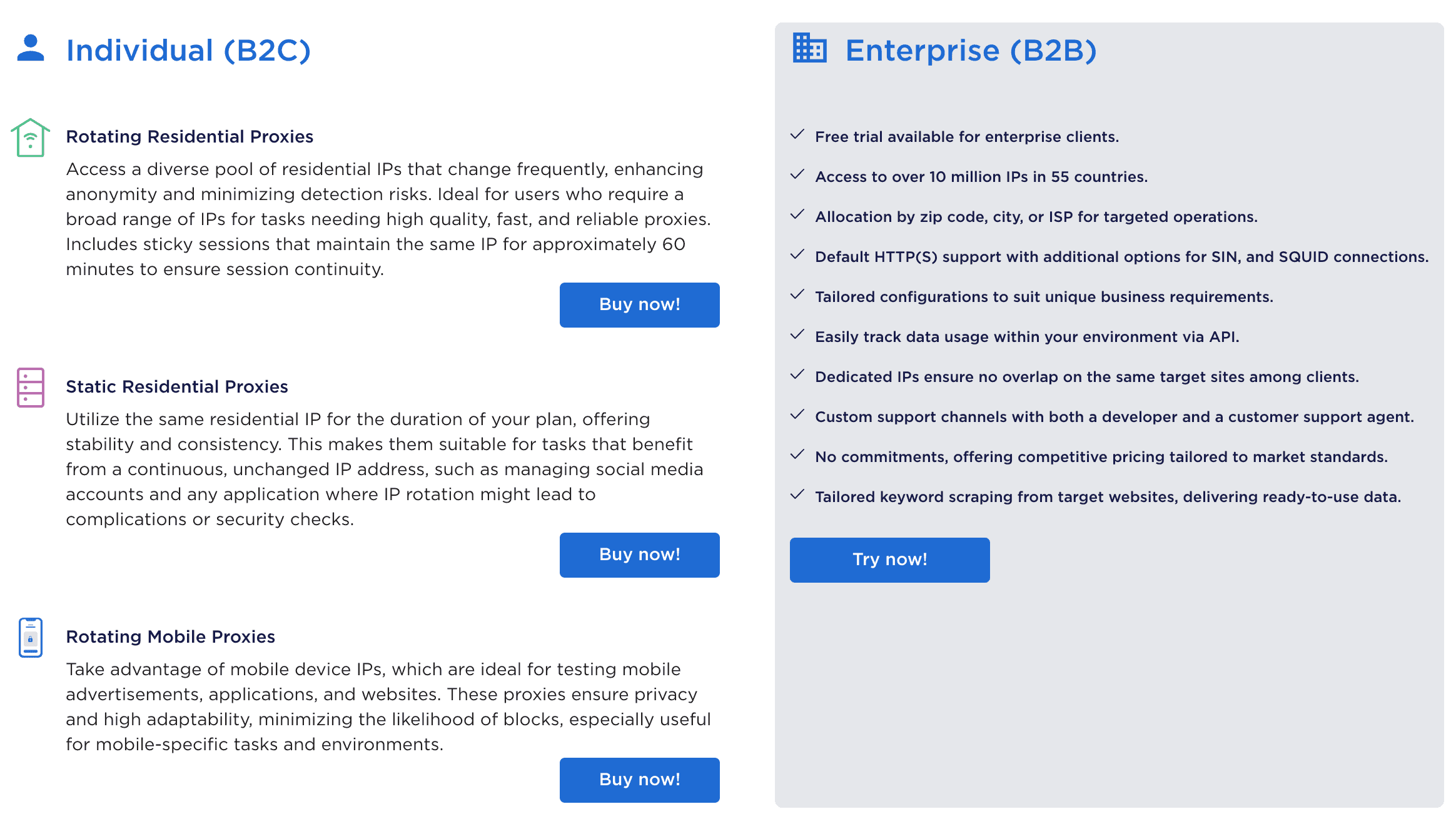
We cover Live Proxies’ proxy networks in detail below.
Live Proxies B2B Residential Proxies
Live Proxies’ B2B residential proxy network is great for web scraping or other large-scale tasks. Like most similar services, it gives access to the full proxy network and meters traffic use.
Unlike the B2C products, this isn’t something you go and buy – Live Proxies will send you through a sales funnel to figure out your individual requirements. As a result, the usage conditions (and even the product’s specifications) may change per customer.
Specifications
- Advertised pool size: 10 million
- Locations: ~55 countries (targetable: US, UK, Canada)
- Targeting: Random, country (on demand: city, ASN, ZIP code)
- Rotation: Every request, 60 mins
- Traffic: Plan based
- Concurrency: Unlimited
- Protocols: HTTP, SOCKS5
- Other: Dedicated server
Live Proxies advertises to control 10 million residential IPs. The number is modest (especially compared to the Chinese providers), but it alone says little in practice.
What does catch the eye is that only around 55 locations are covered. When we tested the service in December 2024, you couldn’t even select that many – just the US, UK, and Canada were explicitly targetable. More can be enabled on demand, but as we’ll see, Live Proxies has a limited number of IPs in other locations.
Unlike the B2C plans, this product supports session control. The configurability is limited, though: you can rotate IPs with every connection request or stick to the same proxy for up to 60 minutes.
There’s one more benefit: according to Live Proxies, it gives each customer a dedicated server.
Integration & Use
- Connection method: Gateway address
- Authentication: Credentials, IP whitelisting
- Connection format
- Credentials:
USERNAME-lv_US-SESSION:PASSWORD@b2b-s1.liveproxies.io:7383 - IP whitelisting: Only for account security purposes
- Credentials:
You can access this proxy network using gateway servers – Live Proxies has several around the world, which reflects in the hostname (b2b, b2b-s1, and so on). Location filters and session parameters are appended to the username.
While IP whitelisting is available (and required), it only serves to protect against unauthorized access – you won’t be able to use the residential proxy network without credentials.
Pricing Plans
- Model: As agreed upon
- Format: Traffic
- Modifiers: As agreed upon
- Starting price: $2,000 for 1 TB ($2/GB)
- Trial: Available upon request
Live Proxies doesn’t provide much concrete information about the pricing of its B2B product. It’s mostly custom and individualized.
We do know two things: the minimum monthly budget ($2,000) and the indicative rates (shown below). They’re actually very competitive when compared to premium and even most mid-market alternatives. The provider told us that it’s prepared to go as low as $0.5/GB.

Performance Benchmarks
We last tested Live Proxies’ B2B residential proxy pool in November 2024.
#1: Pool size & composition
| Gateway | Requests | Unique IPs | Residential %* |
| Global | 1.2M over 14 days | 577,329 | 95.85% |
| US | 560k over 14 days | 307,569 | 99.01% |
| CA | 560k over 14 days | 51,514 | 98.56% |
| UK | 560k over 14 days | 113,252 | 99.45% |
* IP2Location database, Usage type data point, (ISP, ISP/MOB, MOB IPs)
The B2B residential pool was respectably large, especially in the US. We couldn’t test all of our usual locations because they had no separate endpoints.
While the provider’s claim of 55+ locations was true (we actually found nearly 200), 95% of the IPs came from 10 countries, once again dominated by the United States.
#2: Infrastructure performance
- Requests: Same as the pool test
- Target: Nearest server of a global CDN (<10 KB)
| Gateway | Our server location | Avg. success rate | Avg. response time |
| Global | Germany | 95.85% | 1.96 s |
| US | US | 95.96% | 1.58 s |
| CA | US | 94.55% | 1.51 s |
| UK | Germany | 95.15% | 2.20 s |
The infrastructure performance could use improvements. Several days into testing, Live Proxies did make some fixes that raised the success rate to ~97%; but even then, it trails behind all premium competitors. The same goes for the response time.
Live Proxies B2C Proxies
Live Proxies’ B2C networks are best suited for tasks that don’t require many IPs at once.
Their format and characteristics (long uptime, dedicated use, optionally unlimited traffic) make these proxies a strong choice for quality-oriented use cases, such as managing accounts or buying limited edition items. Traffic-intensive jobs like downloading media can be another potential use – but as these proxies are residential, you may find their speed underwhelming.
Specifications
- Advertised pool size: 25-500 IPs (residential), 25-200 IPs (static residential, mobile)
- Locations: Random, US, Canada, UK
- Targeting: Specify a country or US state during purchase
- Rotation: Natural
- Traffic: Optionally unlimited
- Concurrency: Limited concurrent IPs
- Protocols: HTTP
- Other: Dedicated IPs, counts only downloaded traffic
Live Proxies doesn’t advertise how many IPs its full B2C networks include, but that’s hardly relevant – you’ll be accessing 500 proxies at most at any given time. If you opt for unlimited traffic, the number of available proxies is even stricter – it stands between 25 and 50.
In addition, Live Proxies lacks any rotation parameters – you’ll keep the same proxy until it goes offline, and then it will be replaced with another one.
Finally, unlike other residential proxy networks, this one doesn’t give you free control over locations. You can only choose one country (or US state) during purchase, and you remain stuck with it for the subscription period. There is a choice to get a plan with random locations; however, it excludes the US, Canada, and the UK, and you can’t pick individual countries.
These limitations are very strict, but they come with a big benefit – no one else will have access to your proxies while you use them. With the static plans, this means you get exclusive control of a residential device for weeks or even months. There’s one more smaller benefit, as well: only down traffic counts toward your bill.
Integration & Use
- Connection method: Gateway address
- Authentication: Credentials, IP whitelisting
- Connection format
- Credentials:
193.227.129.212:7383:USERNAME-1:PASSWORD - IP whitelisting: Only for account security purposes
- Credentials:
Live Proxies uses backconnect gateway servers for proxy access. These servers come in the format of IP:Port and remain the same for all proxies in one plan. Different proxies are represented by numbers added to the username.
We found that the provider has multiple gateways for different locations to improve speed: for example, connections to UK proxies are made through Amsterdam.
Though Live Proxies technically supports whitelisted IP authentication, it’s only meant for preventing unauthorized proxy access. In other words, there’s no secondary format that would let you access proxies without a username.
Pricing Plans
- Model: Subscription (30-90 days)
- Format:
- Pay for IPs & rolling over traffic
- Pay for IPs only
- Modifiers: Location, plan duration
- Starting price
- Residential: $45 for 200 ports & 4 GB ($11.25/GB)
- Static residential: $65 for 50 ports & 4 GB ($16.25/GB)
- Mobile: $55 for 50 ports & 4 GB ($13.75/GB)
- Trial: ❌
These proxies come with a subscription only. You can choose a period of 30, 45, 60, or 90 days, with longer durations costing extra.
The second variable is the number of IPs you can access at once. The rotating residential product offers the biggest number.
The third variable is location: IPs from random locations cost the least, while US state-targeted proxies charge the most.
The final choice you’ll have to make involves the pricing format. The options here are paying for traffic or shelling out more and enjoying unmetered access.
The traffic-based plans start at four gigabytes per month. For the basic rotating residential plan with 200 IPs, this translates to ~0.66 MB per IP per day, which is a meager amount. Even the largest plan for $500 includes 500 IPs with 50 GB ($10/GB) and equals ~3.33 MB per IP per day. This is very expensive, even compared to premium providers like Bright Data and Oxylabs.
You can’t top up traffic, and subscriptions don’t extend automatically. However, you can buy a standby plan that activates once your current plan expires or runs out of data. In the former case, traffic can roll over, but only if the standby plan shares parameters with your previous plan.
The unlimited traffic plans start at $130 for 25 rotating residential IPs and reach 100 IPs at $330. This sounds like a much better deal, but it doesn’t scale as well. We’re also worried that giving unmetered access to so few IPs at once opens the doors for serious abuse.
All in all, the mixing and matching can get very confusing. Does it make sense to pay more for 60-day access if traffic rolls over? Why can I only get 500 IPs for 60 days or longer? And who in their right mind would buy 350 concurrent IPs with 4 GB of traffic? We have a feeling that Live Proxies designed its pricing model around specific scenarios (like sneaker copping), and it doesn’t always transition well into general use.
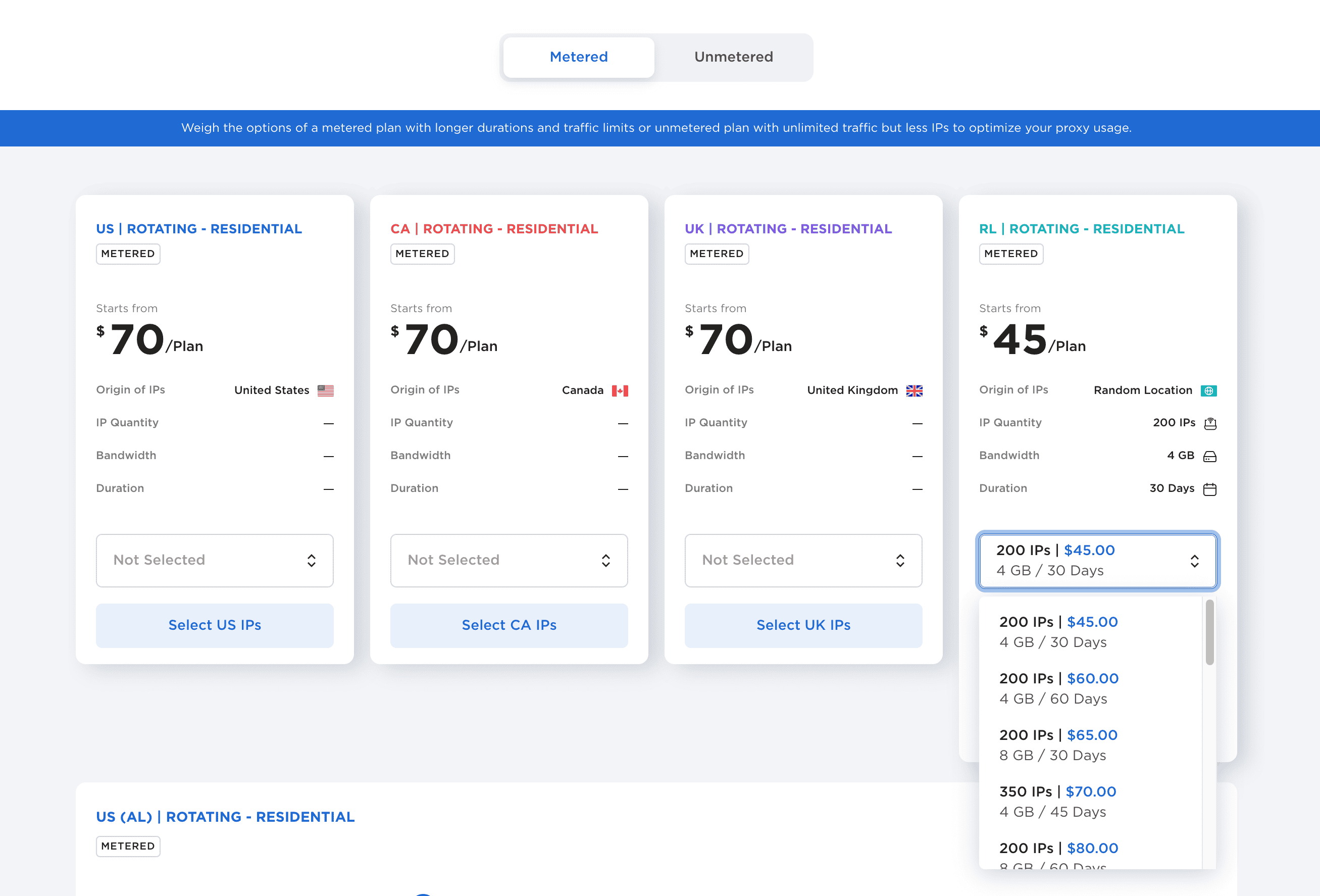
Performance Benchmarks
We last tested Live Proxies’ rotating residential proxies in December 2024.
We had 500 IP plans in the US, UK, and Canada.
#1: Pool size & composition
| Gateway | Requests | Unique IPs | Residential %* |
| US | 560k over 14 days | 2,628 | 98.86% |
| CA | 560k over 14 days | 6,176 | 97.67% |
| UK | 560k over 14 days | 12,599 | 90.54% |
* IP2Location database, Usage type data point, (ISP, ISP/MOB, MOB IPs)
We found very few unique IPs during the testing period, especially in the US. This can be terrible or amazing, depending on your needs. If your preference is stability, then the average uptime of 2.8 days is truly outstanding.
#2: Infrastructure performance
- Requests: Same as the pool test
- Target: Nearest server of a global CDN (<10 KB)
| Gateway | Our server location | Avg. success rate | Avg. response time |
| US | US | 97.29% | 1.23 s |
| CA | US | 99.34% | 0.89 s |
| UK | Germany | 99.53% | 0.37 s |
The residential proxies performed very competitively in two out of the three locations. In the US, their success rate was lower but still respectable.
#3: Download speed
- IPs tested: 10
- Target: Hetzner’s 100MB Ashburn benchmark
| Avg. without proxies | Avg. download speed | Slowest IP |
| 108.69 MB/s | 1.25 MB/s | 0.16 MB/s |
Because it’s possible to buy an unmetered plan and Live Proxies’ IPs barely rotate, we wanted to see how far we could push them. The throughput was typical for a residential proxy network, which is to say – not very far.
#4: Performance with popular targets
- Requests: ~5,200 per target
- Script: Custom non-headless Python scraper; Puppeteer with Extra Stealth for Instagram
- Location: Proxies – US, our server – US
| Avg. success rate | Avg. response time | |
| Amazon | 96.43% | 4.95 s |
| 94.60% | 1.88 s | |
| 96.99% | 3.43 s | |
| Total | 96.01% | 3.51 s |
We normally avoid including benchmarks with real-world targets when we write individual reviews. That’s because the status quo changes fast, and the real value of these tests lies in comparison. However, we decided to add them this time, just to show how well Live Proxies performs.
In brief, the provider’s residential proxies had zero issues with any of our targets, even when we accessed them with tools that are by no means state of the art. This proves that the IPs are of high quality.
How to Use Live Proxies
Registration
To register, you’ll need a name, email address, and password. Alternatively, you can use a Discord or Google account.
Live Proxies doesn’t require undergoing KYC for consumer plans, opting to monitor traffic during use.
Dashboard
Live Proxies has a dashboard for managing subscriptions, setting up proxies, and tracking usage. For now, it’s available in English only.
The dashboard is divided into sections covering each aspect of the service. You’ll also find a notifications hub which is handy for snatching occasional offers. Finally, there’s an option to set up 2FA to secure the account. However, we couldn’t find a way to contact the customer support.
Overall, Live Proxies’ dashboard is well made and simple to operate.
Live Proxies uses Stripe for payments. Buyers of B2C plans can pay by card or Cash App Pay. According to the help docs, B2B customers can also choose PayPal or Zelle.
The dashboard’s home page shows the plans you have active or in standby, as well as how much traffic and days remain to use them. You can’t have multiple plans for one product active at once – the second one will go into standby.
The process of managing payments could be more convenient for recurring users. There’s no wallet, nowhere to save payment details, and you can’t automatically renew or top up a subscription. You’ll have to manually buy standby plans in advance to ensure uninterrupted access.
All orders are listed on the dashboard with their status and downloadable receipts. It’s possible to set up email notifications for traffic thresholds or plan expiration alerts.
Live Proxies provides a widget for setting up and downloading proxy lists. In the case of B2C plans, the widget is very simple – you press a button to reveal your list and then copy or download the results. There’s no way to change the given username or password.
The B2B widget is more interactive: you can choose the session type (sticky or rotating), location, and how many proxies to generate.
IP whitelisting is done in a separate tab. It has no role in proxy setup and is only meant to secure the account.
One thing we missed is that Live Proxies gave us no way to quickly test its proxies. The widget lacked code snippets – even a basic cURL command – and we couldn’t easily access an IP checker. Our guess is that Live Proxies expects customers to use its proxy tester app for this.
Live Proxies has two ways to track traffic use. The first is an interactive graph. It shows traffic expenditure for today, last three, seven, or 14 days.
The second is a table in the Usage Analytics tab. There, you can see more granular statistics: the number of requests made, targeted domains, and connection errors. All columns are freely togglable.
We found two data points in the table harder to understand. Source IP shows the IP address you used when connecting to the proxy server, while Server IP displays Live Proxies’ gateway servers. Because the table aggregates all active plans with no way to specify one, these columns seem like poor substitutes for sub-users and plan segmentation.
In addition, we found it unclear what time span the rows represent. The table divides one day into 11 rows, which fails to translate perfectly into either one or two-hour intervals. These niggles aside, the usage statistics here are decent and more detailed than most.
API Access
While the dashboard does include an API token, its functionality isn’t documented anywhere. So, in practice, API access is not available.
Documentation
Live Proxies has a knowledge center for answering common questions. It’s divided into sections by topic: basic information, troubleshooting, sneaker botting, and account. Each includes its own sub-sections.
The knowledge center is informative overall. However, at the time of writing, some of the information contradicted with the website (for example, the duration of rotating residential proxy sessions or the starting price of the B2B plan). Furthermore, some sections were unfinished, in particular those concerning account management and integration guides.
Hands-On Support
Live Proxies supports customers through its ticketing system or Discord server. The latter requires Stripe’s payment ID to access channels, making it unsuitable for pre-purchase questions. We received access from the provider and had no payment ID, so Discord was a no go.
Thankfully, the ticketing system option is available for everyone. We filled in the necessary fields (email address, name, subject, and message) and were promised to receive assistance within 24 hours. A reply came in around two hours, which is okay.
Live Proxies told us that the Discord server always has at least one agent on standby. It also integrates with the same ticketing system we used.
Conclusion
If you read this review carefully, you might have noticed how many sentences had negative constructions: can’t, don’t, and so on. In some ways, Live Proxies truly is limited, at least when compared to many of our reviewed residential proxy providers.
The B2C business line? Expensive. Opinionated. Premium. Definitely not our choice for all scenarios, but there are areas where it surely shines. If they intersect with what you’re trying to achieve, then you might just become a very happy camper.
The B2B pool? To be honest, it’s still pretty raw. However, Live Proxies’ pricing and willingness to accommodate make a compelling case for giving it a try. This stands especially true for the US, where the provider commands its strongest presence.

Oxylabs is like a premium version of Smartproxy. It controls a significantly larger IP pool, and you can get specialized APIs that simplify web scraping.

Bright Data is another strong option with more features and powerful proxy management tools. It also sells proxy-based web scraping APIs and even complete data sets.

The options above are expensive. Let’s go the other way. PacketStream offers some of the cheapest residential proxies on the market with rotation every request and sticky sessions.
Want more? View the full list of the Smartproxy alternatives.
Recommended for:
Anyone looking for quality niche proxies or a highly customizable residential IP pool.
